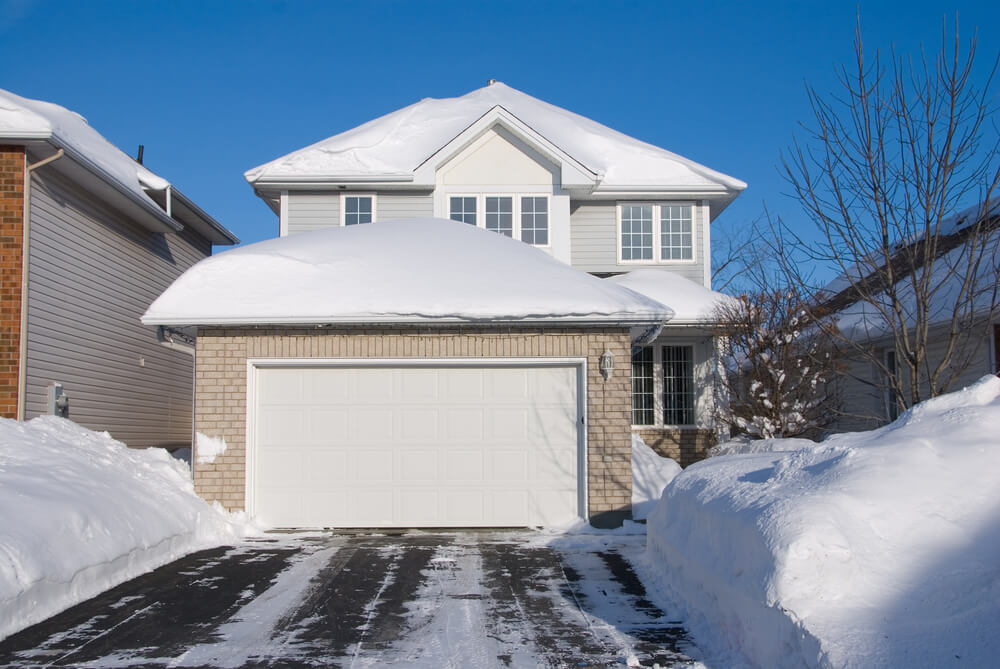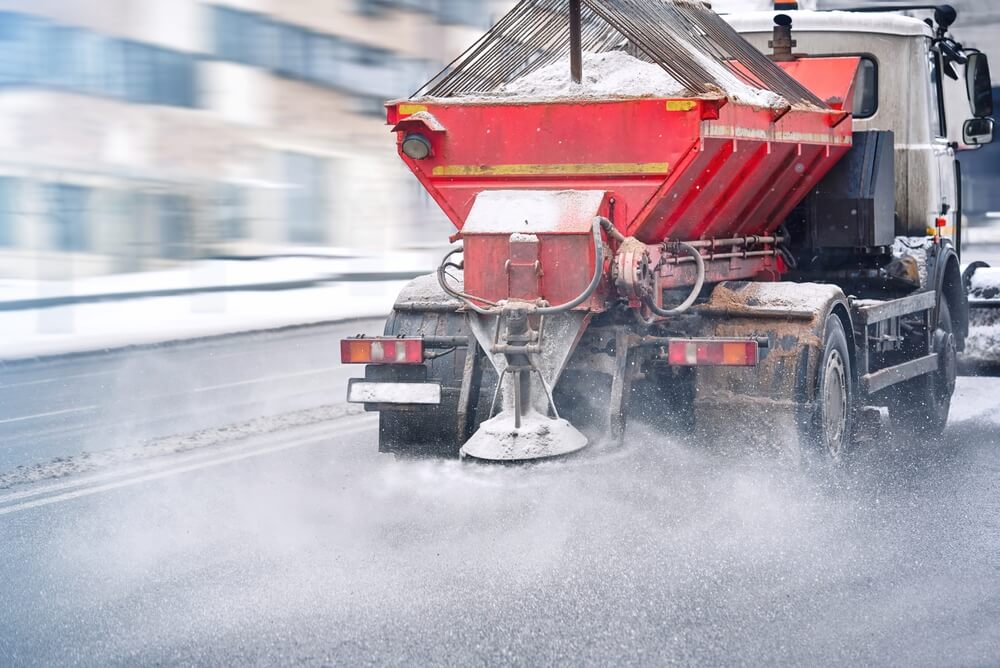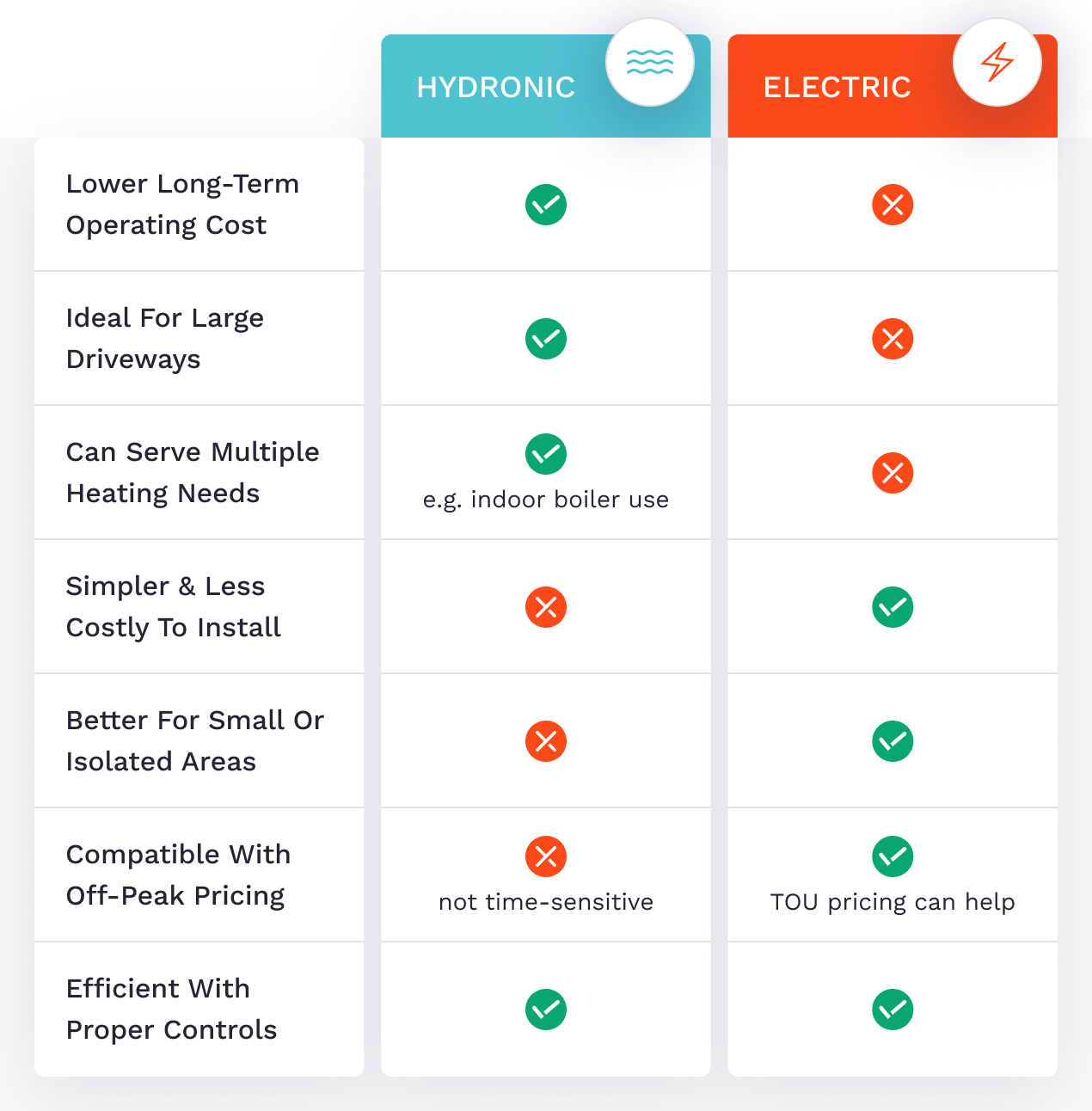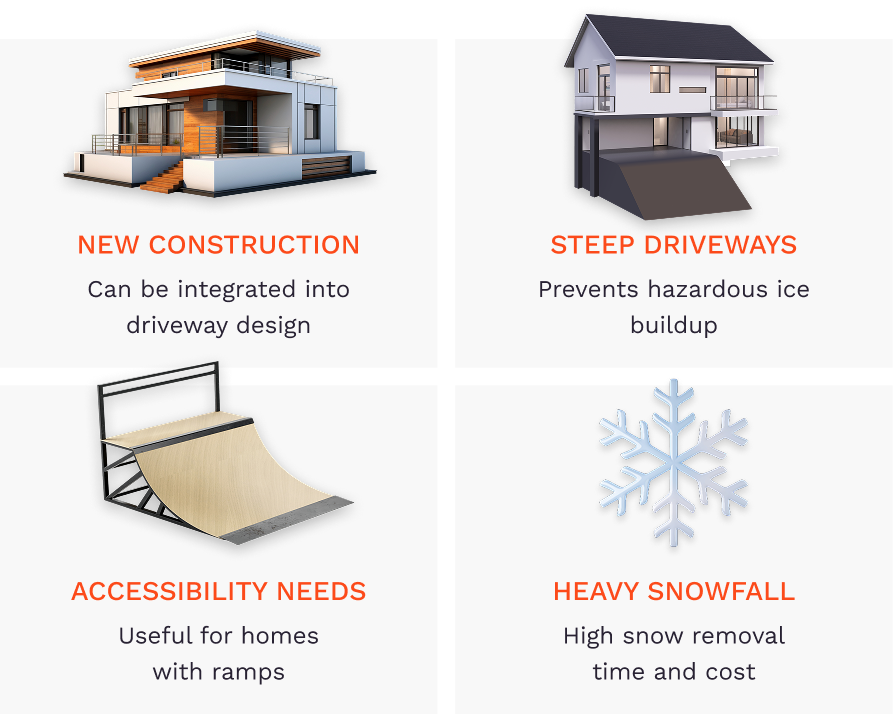How Much Energy Does Driveway Heating Use in 2025? (Price Breakdown)

- Electric heated driveways typically use 50–80 watts per square foot
- For a 500 sq. ft. driveway, that’s about 25–40 kWh per hour of operation
- In peak winter months, usage can average $150–$300/month
Thinking about installing a heated driveway in Toronto but worried about the energy use?
In 2025, with electricity rates averaging $0.13–$0.17 per kWh in Ontario and natural gas costs hovering around $0.40 per cubic metre, knowing what it’ll actually cost to melt snow off your driveway is more important than ever.
On average, a heated driveway uses 50 to 80 watts per square foot. That means a 500 sq. ft. driveway could draw 25,000 to 40,000 watts when active—adding $150 to $300 per month to your energy bill, depending on local rates and usage time.
How Heated Driveways Work: System Types and Energy Use
Electric vs. Hydronic: The Two Main Radiant Heat Systems
An electric heated driveway uses resistance cables embedded beneath the surface. When switched on, these cables convert electricity directly into heat. The cables are arranged to ensure even coverage and are usually controlled by a thermostat or snow sensor that activates the system during precipitation combined with low temperatures. This makes the system relatively straightforward to install and operate.
Hydronic systems, on the other hand, use a closed-loop network of tubing filled with heated water or a water-glycol mix. A separate boiler or water heater warms the fluid, which is then circulated beneath the driveway surface. The result is the same: snow melts on contact. The setup is more complex, but long-term pricing can be lower.
Power Requirements and Operating Costs of a Heated Driveway
To melt snow effectively, driveway heating systems must generate enough energy to counteract snow accumulation during a storm. This is usually expressed in watts per square foot, or Btu/h·ft², a way to measure how much heat the system provides relative to surface area.
In a city like Toronto, a typical “average exposure” driveway, one that isn’t sheltered or shaded, requires around 25 to 30 watts per square foot (or 85 to 95 Btu/h·ft²) during active snow events. This level of energy is needed to keep the driveway bare during what’s known as a “design storm”, which is a weather event used in engineering models to represent worst-case conditions.
To put this in context, a small driveway heating system may require as much as 250,000 Btu/h, which equals roughly 73 kilowatts. However, this isn’t continuous use. Most systems operate only when snowfall is detected, and even then, they usually run intermittently. On average, systems are active for just 17% of total winter hours.
It’s important to note that much of the above data is made up of modeled averages, not fixed truths. Energy needs will vary depending on system efficiency, local weather patterns, the slope and material of the driveway, and how frequently the system is used. A poorly insulated or misconfigured system may use far more energy.
How Much Would the Electricity Cost to Heat a 50-foot Driveway Heating System?
Consider a 50-foot-long driveway that’s 10 feet wide: a total of 500 square feet. For an electric system rated at 30 watts per square foot, the energy demand during snow-melt mode would be 15,000 watts, or 15 kilowatts.
If the system runs for 17% of a 3,000-hour winter season (approximately 510 hours), it would consume:
15 kW × 510 hours = 7,650 kilowatts per hour rate (kWh).
The actual cost of this energy depends heavily on your local power utility’s Time-of-Use (TOU) pricing. In Toronto, as of November 2024, TOU rates are:
- 7.6¢/kWh (off-peak)
- 12.2¢ per kWh (Mid-peak)
- 15.8¢/kWh (on-peak)
- 2.8¢/kWh with the new Ultra-Low Overnight (ULO) rate between 11 p.m. and 7 a.m.
If the system draws all its power during peak hours, an unlikely but technically possible scenario, the seasonal cost would be:
7,650 kWh × 15.8¢ = $1,209.
If instead, the system operates only during the overnight low-rate window, the cost would drop dramatically:
7,650 kWh × 2.8¢ = $214.
Realistically, the true cost will fall somewhere in between, depending on the timing of snow events and the control settings on the system. Most homeowners won’t pay the full peak rate unless the system is manually controlled and left running unnecessarily. Many setups include smart thermostats or weather sensors that activate heating only when needed, optimizing energy use.
Heated Driveway’s Operating Cost: Hydronic vs. Electric
Hydronic Heated Driveway Cost Example
Hydronic systems have the potential to be more economical over time, especially in regions where natural gas remains affordable. Unlike electric systems, which convert power directly to heat, they distribute heat from a single boiler or water heater, making them more efficient in heating larger areas.
In one modeled example, a 1,000-square-foot gas-fired hydronic systems cost around $360 per winter to operate. That’s less than half the upper-end estimate for electric systems of comparable size.
Broadly, operating costs for hydronic systems in many Canadian cities fall under $750 per season, depending on boiler efficiency, insulation, and snowfall frequency.
These systems often benefit from zone controls that allow homeowners to heat only the parts of the driveway they need, for instance, tire paths or walkways rather than the entire surface. This can lower both energy consumption and long-term utility bills.
Electric Heated Driveway System Cost Example
Electric systems vary more widely in cost depending on usage habits and electricity rates. A typical electric heated driveway system may cost between $120 and $600 per winter to operate, though this can rise if the system is oversized or left on during mild weather.
For example, a smaller 300-square-foot electric system running at 25 W/ft² for 400 hours would use:
300 × 25 = 7,500 W = 7.5 kW
7.5 kW × 400 hours = 3,000 kWh
At an average rate of 10¢/kWh, that comes to $300 for the season.

Installation Costs: New Builds vs. Retrofitting an Existing Driveway
Electric Heated Driveway Installation Costs
Installation costs for electric systems heated driveway systems are often more straightforward and affordable than their hydronic systems counterparts, especially for small or medium-sized driveways.
Electric systems typically cost between $14 and $24 per square foot to install, depending on local labour rates, the complexity of the layout, and whether it’s a new build or a retrofit. For a 500-square-foot driveway, this translates to a total installation cost between $7,000 and $12,000, assuming the surface must be lifted and replaced to embed the heating cables. If the system is installed during new construction or major renovations, the cost may fall closer to the lower end of that range.
Hydronic Installation Costs
Hydronic systems tend to have higher upfront costs, largely because of the need for a boiler, pumps, manifolds, and insulated piping. The tubing itself must be installed beneath the surface, and the boiler system needs sufficient indoor or outdoor space.
Installation costs usually fall between $12 and $34 per square foot, putting the total for a 500-square-foot installation at $6,000 to $17,000. That said, in homes with existing radiant heating infrastructure, integration costs may be lower, especially if a central boiler can serve multiple systems, including floors, basements, and garage slabs.
Retrofitting Costs
Retrofitting an existing driveway typically ranges from $7 to $17 per square foot, but full teardown-and-rebuild projects can exceed $16,000, especially for concrete or stone driveways. In most cases, retrofitting existing driveways will demand higher prices than installing a driveway from scratch.
Sometimes, partial retrofits, such as adding heating to a ramp or primary tire paths, can help reduce costs while still providing most of the benefits. However, the disruption and timeline should be carefully considered before committing to a retrofit.
Environmental Drivers: Reducing Salt and Chemical Use
Beyond comfort and convenience, heated driveway snow melting systems are increasingly being promoted as an environmentally conscious alternative to traditional snow-clearing methods. Each year, Canadians apply approximately 5 million tonnes of road salt to driveways, sidewalks, and roads. While effective at lowering the freezing point of water, salt can corrode concrete driveway surfaces and metal, damage surrounding vegetation, and leach into groundwater systems.
Environment and Climate Change Canada classifies chloride-based road salts as CEPA-toxic, due to their adverse effects on aquatic life and drinking water sources. The accumulation of salt runoff in urban waterways is a growing concern, particularly in densely populated areas where widespread application is common during harsh winters.

Heated driveway snow melting systems eliminate, or significantly reduce, the need for de-icing chemicals. By preventing snow and ice accumulation from the outset, they avoid the repeated cycles of melting, salting, and re-freezing that can cause the abovementioned damage. This not only preserves nearby landscaping and surface materials but also helps municipalities reduce chemical loads in local drainage systems.
While it’s important to note that heated snow melting systems consume energy which may come from fossil-fuel sources, many homeowners see the trade-off as worthwhile. Especially in urban or environmentally sensitive areas, reducing chemical use and runoff can be a compelling reason to consider a driveway heating system.
Energy Efficiency Standards and Safety Updates for 2025
As the technology for a radiant heat system evolves, so do the codes and standards governing its use in Canadian homes. Both energy efficiency and safety are now front of mind for regulatory bodies.
In cold regions like Toronto, CSA B214 (2021) now mandates 25 millimetres (R-5) of insulation beneath any outdoor slab containing hydronic tubing. This helps reduce heat loss to the ground and improves system responsiveness. Without proper insulation, much of the system’s energy would be wasted beneath the slab, rather than directed upward toward the snow surface. For electric systems, updates to the 2024 Ontario Electrical Safety Code require that all snow-melt branch circuits include ground-fault protection limited to 30 milliamps (mA) or less, minimizing the risk of electrical shocks due to moisture exposure or wire damage. Other efficiency gains come from improvements in electric heating cables, many of which are now designed to withstand repeated freeze-thaw cycles and prolonged exposure to moisture. Modern systems also feature more responsive snow sensors and weather-based controls that reduce unnecessary run-time.
Homeowners considering a new system in 2025 will need to ensure compliance with these updated codes. Working with a licensed contractor familiar with local regulations is essential, especially when integrating heating elements into existing infrastructure.
Cost Trends and Economic Pressures in Heated Driveway Installation
In Toronto, the Building Construction Price Index (BCPI) rose 5.3% year-over-year in Q4 2024, reflecting increases in materials, labour, and energy equipment costs. The BCPI reached a value of 113.6, meaning that construction expenses for residential projects are now more than 13% higher than they were just a few years ago. This upward trend affects not just the approximate operating cost of heating systems but also the concrete, pavers, and finishing materials required to complete the job. These rising costs are prompting some homeowners to consider phased or partial installations, heating only key areas such as tire tracks or walkway paths rather than the full driveway. Others may delay projects until construction prices stabilize.
Nonetheless, demand remains strong in certain sectors, particularly among new builds and high-end residential developments. As climate variability increases and weather extremes become more common, the value placed on reliable winter access continues to rise, despite economic headwinds.
Canada’s Housing Stock and the Demand for Snow-Melt Systems
Canada’s aging housing stock is undergoing a wave of energy-focused upgrades. According to government projections, around 15 million homes across the country are being targeted for energy retrofits through various federal and provincial programs. While many of these efforts are focused on insulation, HVAC upgrades, and window replacements, they also create opportunities to integrate systems like radiant snow-melt, especially when driveways are being rebuilt or regraded.
Older homes in snowy regions are prime candidates for heated driveways, especially where accessibility is an issue. Sloped or long driveways that require frequent maintenance during winter can be made safer and easier to use with integrated heating, reducing the need for manual labour or expensive third-party removal services. In high-snowfall areas or communities where aging populations are concentrated, the demand for permanent snow-removal solutions is growing. With ever increasing numbers of homes being modernized for better energy performance, many homeowners are choosing to include heated surfaces as part of broader lifestyle upgrades.
Electricity and Gas: The Real Price Per Energy Unit in 2025
One of the main factors influencing the approximate operating cost of running a heated driveway system is the type of energy you use and what you pay for it. For natural gas, the delivery charge for Enbridge Rate 01 customers is 17.4897¢ per cubic metre (m³) as of early 2025. Using Natural Resources Canada’s conversion rate of 1 m³ = 10.55 kilowatts per hour rate (kWh), that means homeowners are paying roughly 1.66¢ per kWh for gas delivery. When factoring in commodity and transportation charges, the effective cost of gas heat required is still significantly lower than peak-hour electricity rates.
By contrast, electricity rates can vary widely depending on time of use. With Time-of-Use pricing from Toronto Hydro, rates range from 2.8¢/kWh during the overnight window (11 p.m. to 7 a.m.) to 15.8¢/kWh during daytime peak periods. That’s nearly a sixfold difference.
This pricing structure means hydronic systems powered by gas often have the advantage for large driveway heating systems, especially where the boiler can be used for multiple heating needs. However, electric heated driveway homeowners may find electric heating cables competitive for smaller areas or properties that already use electricity exclusively.

When evaluating long-term heated driveway’s approximate operating cost, homeowners should compare these energy rates in real terms. What looks cheaper on paper may not always align with the actual usage patterns of your snow-melt system, particularly if you’re heating large surfaces during high-demand times.
How Heated Driveway Use Compares to Household Energy Use
In 2021, the average Canadian household used 85.4 gigajoules (GJ) of energy, which is equal to 23,700 kilowatts per hour rate. In Ontario specifically, the figure was slightly higher in 2019, with households averaging 94.8 GJ, or roughly 26,300 kWh.
Depending on the size and usage of your driveway system, seasonal consumption could range from 3,000 to 8,000 kilowatts per hour rate, equivalent to 13% to 34% of your annual household energy use. This is a significant proportion, especially in homes trying to lower their carbon footprint or manage rising local power utility company bills. While not every system operates continuously, even intermittent use adds up across long Canadian winters.
For some homeowners, this may raise questions about energy efficiency and sustainability. In others, it reinforces the value of systems that are well-designed, insulated, and controlled by responsive sensors to minimize waste.
Affordability and Financial Pressure on Canadian Homeowners
In 2023, nearly 10% of Canadians reported being late or unable to pay an energy bill at least once due to affordability concerns. This reflects the growing strain of inflation, utility rate increases, and housing costs on household budgets.
For those already struggling with rising expenses, the idea of installing a system that could consume several thousand kilowatt-hours per year may seem unrealistic. However, for homeowners with greater financial flexibility or for those seeking long-term accessibility upgrades the investment can still be justified. Some provinces offer rebate programs for energy-efficient heating upgrades, including radiant floor systems. While not always directly applicable to driveways, these programs may offset related costs if the system is integrated with other household upgrades.
Ultimately, affordability is highly personal. What one household considers an essential safety feature may be an unaffordable luxury for another. Making an informed choice requires evaluating current energy rates, home design, climate needs, and your financial situation all together.
Best Situations for Heated Driveway Installation
The best candidates for snow-melt systems include new builds, where installation can be integrated into the driveway design from the outset. This avoids the extra cost and disruption of retrofit work.
Steep or sloped driveways are also good fits, as snow and ice accumulation in these areas can pose major safety hazards. Keeping them clear ensures vehicles can exit safely and pedestrians don’t slip on their way in or out.
Accessibility needs are another compelling factor. Homes with wheelchair ramps, elderly residents, or frequent foot traffic can benefit significantly from a system that keeps surfaces clear without requiring manual labour.
Finally, properties in regions with heavy snowfall, including parts of Ontario, Quebec, and Alberta, are obvious candidates. In these areas, the time and cost of snow removal can add up quickly, making the investment in a reliable snow-melt system more palatable.
CANDIDATES FOR SNOW-MELT SYSTEMS

Limitations and Manual Alternatives
Despite their appeal, heated driveways come with drawbacks that should be considered carefully.
- First is cost, as both installation and ongoing operating expenses are substantial. If not well-designed or maintained, systems can suffer from inefficiencies or outright failure.
- Repairs can also be complex. In the event of a malfunction, especially in an embedded electric cable, reaching the problem may require breaking into the driveway surface, which can be a costly and time-consuming process.
- Then there’s the issue of energy demand. Even if your system uses off-peak electricity or natural gas, the extra consumption adds pressure to utility grids and contributes to overall emissions, unless offset by clean energy sources.
For many homeowners, manual methods remain more practical. Snowblowers, snow-melting mats, or professional snow removal services offer effective alternatives, though they require more effort or recurring fees. In some cases, combining these approaches (e.g., heated mats on steps with manual driveway clearing) provides a useful middle ground.
Is a Heated Driveway Worth It in 2025?
A heated driveway can make winter more manageable, but whether it’s worth it depends on your home, budget, and climate. Systems offer real benefits: they prevent snow accumulation, reduce liability, and eliminate the need for constant manual removal.
Energy use can be significant, especially for larger or frequently active systems. Yet with proper design, insulation, and smart controls, the overall impact can be practical. Hydronic systems offer lower operating costs over time, while electric systems provide simplicity and fast installation.
As 2025 unfolds, heated driveways are likely to become more common, especially in new developments and high-snowfall regions. For some, they remain a luxury. For others, they are an investment in safety, convenience, and environmental care.
Want to find out more? Contact Heavenly Heat Inc. today and get an estimate for a heated driveway tailored to your needs.
The statistics and facts in this article are based on available data as of the publication date. While efforts have been made to ensure accuracy, details can change over time. This content is therefore for informational purposes only and should not be used as professional advice.
